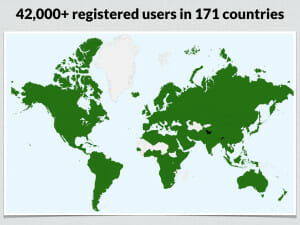Here in central Indiana, we’re starting to see a few sneak previews of Spring. For someone who doesn’t care much for cold winters, I always anticipate the warmer weather and nature’s many signs of new growth. Overcast skies do amplify your appreciation of sunny days, but I’m grateful that LOINC community continues to grow year round.

photo via Marjaana Pato
In fact, it can be hard to keep with everything happening in LOINC-land. Our vision is for LOINC to be integrated into every clinical information system that shares or aggregates data. Man, I know that sounds audacious, but we believe that LOINC becomes more valuable as more people use it. Each new initiative using LOINC means that there is more health data understandable to different computer systems.
Here, I’m going to summarize the key LOINC updates from the last few months.
LOINC user growth

Over the last few months, LOINC use and adoption has continued to grow around the world.
- There are now more than 42,000+ registered users in 171 countries.
- We add 5,000 to 6,000 new registered users on loinc.org each year.
- The main loinc.org website gets about 35,000 page views each month.
- The LOINC Search App has about 5,000 unique visitors each month.
The LOINC web traffic comes from all over the globe. The top 10 countries of our visitors are:
- United States
- India
- Canada
- Germany
- Italy
- France
- Netherlands
- Australia
- United Kingdom
- Spain
Key presentations and publications
Because of our academic bent, the LOINC team wants to disseminate knowledge about LOINC through publications and presentations to various audiences.
Supporting interoperability of genetic data with LOINC
Genetic testing is an important and rapidly growing area. This paper describes LOINC’s model for representing the wide scope of genetic tests, including codes for cytogenetic or mutation analysis tests, specific chromosomal alteration or mutation testing, and fully structured discrete genetic test reporting.
Deckard J, McDonald CJ, Vreeman DJ. Supporting interoperability of genetic data with LOINC. J Am Med Inform Assoc. 2015 Feb 5. PMID: 25656513.
Learning from the crowd while mapping to LOINC
In a series of two papers, we described our project to build a shared repository of local tests mapped to LOINC codes. We seeded the repository and then made information about those prior mappings available to LOINC mappers while they were doing their work. Study participants who accessed that information agreed that it was useful and informed their mapping choices
Dixon BE, Hook J, Vreeman DJ. Learning From the Crowd in Terminology Mapping: The LOINC Experience. Lab Med. 2015 Spring;46(2):168-74. PMID: 25918199 .
Vreeman DJ, Hook J, Dixon BE. Learning from the crowd while mapping to LOINC. J Am Med Inform Assoc. 2015 Jul 29. pii: ocv098. doi: 10.1093/jamia/ocv098. PubMed PMID: 26224334.
International Perspectives and Strategies for LOINC Adoption
At the MedInfo 2015 conference in São Paulo, Brazil I organized a panel to discuss different approaches to LOINC adoption around the world. I was joined by Marivan Santiago Abrahão who discussed the approach in Brazil and Maria Teresa Chiaravalloti who shared the Italian perspective. We had a wonderful session that was both live-streamed and recorded. (I am still hoping to get the posted on the LOINC website).
My slides from this session are available:
Top 10 Tips for Mapping to LOINC
On January 21, 2016 I gave a presentation in a PCORnet best practices session to introduce LOINC and share some mapping tips. I summarized and expanded on that presentation in subsequent post that is a great place to start for anyone looking to map their local codes to LOINC codes. Read my Top 10 Tips for Mapping to LOINC here.
Recommendations to NCVHS on Attachment Standards
On February 15, 2016 I gave testimony to NCVHS about the proposed use of LOINC in the context of claims and other attachments. Read the summary of my testimony here.
U.S. Federal adoptions and use of LOINC
ONC 2016 Interoperability Standards Advisory
The final version of the ISA was published December 22, 2015. In this version, ONC has named LOINC as the best available vocabulary standard for lab tests, imaging (diagnostics, interventions, procedures), and vital signs.
In addition, they’ve started to recognize the question/answer model that is so prevalent in health data storage and exchange.
In this version, ONC has added a new section of projected additions to the ISA. Many (but not all) of the domains I’ve recommended did appear in this “coming soon” section, including:
- Representing patient family health history observations (questions)
- Representing patient gender identity observations (questions)
- Representing patient sex (at birth) observations (questions)
- Representing patient-identified sexual orientation observations (questions)
- Representing numerical laboratory test order observations (questions/what will be tested)
- Representing nursing assessments
- Representing outcomes for nursing
- Representing patient tobacco use (smoking status) observations (questions)
There are still some funny things about how ONC has approached these domains that I’ll be making recommendations on in the public comment period (stay tuned).
FDA Adoption and Promotion of LOINC
The FDA continued to advance its promotion of LOINC throughout 2015. In January, LOINC was added to its list of recognized standards. In May, the FDA published a notice encouraging sponsors and applicants to provide LOINC codes for clinical laboratory test results in investigational study data that is part of regulatory submissions. And, over the course of the year we had many conversations leading up to the September Workshop on Promoting the Interoperability of Laboratory Data. This workshop advanced the discussion of in vitro diagnostic companies making prominent the LOINC codes that apply to their tests. And last, the FDA recently published draft guidance for pre-market submissions of medical devices emphasizing the key role of consensus based standards for their interfaces. Obviously, LOINC can be a key ingredient in making the outbound data from medical devices understandable to other systems.
Meaningful Use 2015 Criteria
As usual, the major 2015 news in health IT were the new Meaningful Use criteria. Overall, there were 87 mentions of LOINC in the final rule.
Some of the criteria not adopted for 2015 that relate to LOINC include those for vital signs, image results and sending/receiving lab results. Somewhat surprising (and disappointing) was the lack of any named standards for lab or diagnostic imaging ordering.
New criteria for 2015 with implications for LOINC include the capturing of social, psychological, and behavioral data and patient health information capture. The final rule identified specific LOINC codes, organized in this panel, for many of the key domains.
Highlights from the latest LOINC release
The December 2015 LOINC release was a whopper. I won’t rehash all of the details here because the release announcement summarizes them all. Kudos to LOINC team for a spectacular job.
Update on LOINC collaborations with other standards development organizations
IHTSDO
We continue our quarterly executive policy group meetings. We’re still pursuing the ability to distribute SNOMED CT codes connected to the answer lists hooked up LOINC question codes. (Coming soon).
I co-presented with Suzanne Santamaria from IHTSDO at the at SNOMED CT Expo 2015 in Montevideo, Uruguay. You can read a summary of our presentation Using LOINC and SNOMED CT Together without Overlap here.
In September 2015, Regenstrief and IHTSDO published a Technology Preview of our joint work to link LOINC and SNOMED CT. You can get the file from the LOINC website in three formats: RF2, OWL, Excel (with term names!).
Though still a work-in-progress, these files contain:
- 14,736 LOINC Terms associated with SNOMED CT post-coordinated Expressions
- 4,400 LOINC Part to SNOMED CT mappings
They cover the majority (around 75%) of the Top 2000 LOINC Lab Observations and Parts needed to represent them. It’s also interesting to note that 1500+ SNOMED CT codes were added to International release of to produce these expressions.
RSNA
We also continue our active collaboration with RSNA to unify the LOINC and RadLex terminology models for radiology procedures.
The general idea is to create a single standard for radiology procedures and a unified governance process. The LOINC code will be the universal identifier, linked to a detailed set of metadata attributes that define the procedure name. The attribute values will be represented as RadLex RIDs.
We completed our first phase in September 2015, which covered unified names for computed tomography procedures. We kicked off Phase II in October 2015 to complete the unification work for the procedures names of the other modalities. As the content work in those domains is completed, it will be added to the LOINC/RSNA Radiology Playbook file published on the LOINC website.
Wrap-up
There you have it! No shortage of cool stuff happening with LOINC. My goal is to provide regular updates here on what we’ve got cooking.
